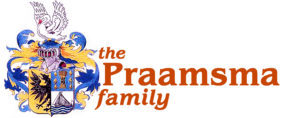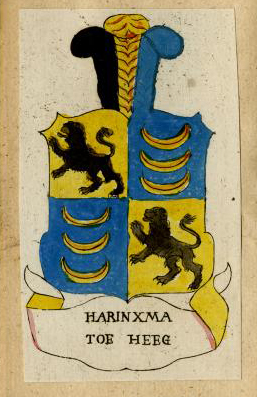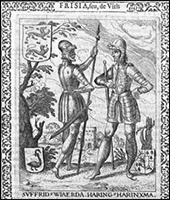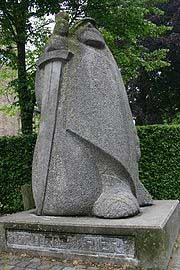Haring Harinxma and Grutte Pier
HARING HARINXMA DONIA was a powerful Frisian chieftain and Schieringer. Another title used by Haring was thoe Heeg meaning "of Heeg," where he was born and lived.
The Schieringers and Vetkopers were two opposing Frisian factional parties from the medieval period. Vetkopers ("fat buyers") had much and could buy fat products; the poor adopted the name Schieringers ("speakers") because they had tried firstly discussion rather than violence.
The Schieringers elected Haring Harinxma Potestate (a governor chosen by the Frisians under the authority of the royally appointed counts), together with Sjoerd Wiarda, of Oostergo (eastern region of Friesland) in the struggle against the count of Holland in 1399.
A famous descendent of Harinxma was Pier Gerlofs Donia.
PIER GERLOFS DONIA was a Frisian warrior, pirate, rebel, and freedom fighter, best known by his Frisian nickname "Grutte Pier" ("Big Pier"), or the Dutch "Grote Pier" and "Lange Pier," which referred to his legendary size and strength.
Grutte Pier was born Pier Gerlofs Donia, one of at least four children of Gerlof Piers and Fokel Sybrants Bonga (daughter of the Schieringer noblemen Sybrant Doytsesz Bonga of Bongastate, Kimswerd). Pier Gerlofs married Rintsje Syrtsema and they had two children. Pier and his brother-in-law Anne Pijbes (husband of our ancestor Tijdt Gerlofs), were partners in the farming estate of Meyllemastate in Kimswerd.
The Black Band, a notoriously violent regiment in the service of the Duke of Saxony, was quartered in the nearby town of Franeker, charged with suppressing the civil war between the Vetkopers (who opposed Burgundian and subsequently Habsburg rule) and the Schieringers. On 29 January 1515 the Black Band plundered Donia's village, then allegedly raped and killed his wife and burnt to the ground both the village church and Donia's estate. Seeking revenge, Pier started a guerrilla war campaign against the Habsburgs and allied himself with the Duke of Guelders, the foremost opponent of the Habsburgs.
Pier's armed band, pirates known as the Arumer Zwarte Hoop, captured many English and Dutch ships, mainly on the Zuider Zee. In his biggest battle, in 1515, he captured 28 Dutch ships, earning him the nickname "Cross of the Dutchmen." He was very active in 1517, when he used his "signal ships" to attack ships in the region of the West Frisian coast, to which he also transported Geldrian forces, setting them ashore at Medemblik.
Medemblik's governor, Joost van Buren, succeeded in keeping the aggressors outside the castle walls. Unable to take the castle, the Arumer Zwarte Hoop plundered the town and set it on fire. With most houses made of wood, the town, including the church, monastery and town hall, were completely razed. After this partial victory, Pier and his army stormed both Nieuwburg and Middleburg Castle near Alkmaar, leaving only ruins. Shortly after this victory, Pier defeated 300 Hollanders in Hindelopen.
Despite his successes, Pier could not turn the Burgundian/Habsburg tide and he retired, disillusioned, in 1519. His nephew, Wierd Jelckama, took over the command of Pier’s forces. On 18 October 1520 Pier died peacefully in Sneek, where he is buried.
Today, a great sword that is said to have belonged to Pier is on display at the Fries museum in Leeuwarden. There is a Statue of Grutte Pier in his hometown of Kimswerd. The legendary status of Grote Pier as a hero or a villain has endured over the centuries with his exploits retold in book, poetry, song and more recently television.

HARING HARINXMA DONIA was a powerful Frisian chieftain and Schieringer. Another title used by Haring was thoe Heeg meaning "of Heeg," where he was born and lived.
The Schieringers and Vetkopers were two opposing Frisian factional parties from the medieval period. Vetkopers ("fat buyers") had much and could buy fat products; the poor adopted the name Schieringers ("speakers") because they had tried firstly discussion rather than violence.
The Schieringers elected Haring Harinxma Potestate (a governor chosen by the Frisians under the authority of the royally appointed counts), together with Sjoerd Wiarda, of Oostergo (eastern region of Friesland) in the struggle against the count of Holland in 1399.
A famous descendent of Harinxma was Pier Gerlofs Donia.
PIER GERLOFS DONIA was a Frisian warrior, pirate, rebel, and freedom fighter, best known by his Frisian nickname "Grutte Pier" ("Big Pier"), or the Dutch "Grote Pier" and "Lange Pier," which referred to his legendary size and strength.
Grutte Pier was born Pier Gerlofs Donia, one of at least four children of Gerlof Piers and Fokel Sybrants Bonga (daughter of the Schieringer noblemen Sybrant Doytsesz Bonga of Bongastate, Kimswerd). Pier Gerlofs married Rintsje Syrtsema and they had two children. Pier and his brother-in-law Anne Pijbes (husband of our ancestor Tijdt Gerlofs), were partners in the farming estate of Meyllemastate in Kimswerd.
The Black Band, a notoriously violent regiment in the service of the Duke of Saxony, was quartered in the nearby town of Franeker, charged with suppressing the civil war between the Vetkopers (who opposed Burgundian and subsequently Habsburg rule) and the Schieringers. On 29 January 1515 the Black Band plundered Donia's village, then allegedly raped and killed his wife and burnt to the ground both the village church and Donia's estate. Seeking revenge, Pier started a guerrilla war campaign against the Habsburgs and allied himself with the Duke of Guelders, the foremost opponent of the Habsburgs.
Pier's armed band, pirates known as the Arumer Zwarte Hoop, captured many English and Dutch ships, mainly on the Zuider Zee. In his biggest battle, in 1515, he captured 28 Dutch ships, earning him the nickname "Cross of the Dutchmen." He was very active in 1517, when he used his "signal ships" to attack ships in the region of the West Frisian coast, to which he also transported Geldrian forces, setting them ashore at Medemblik.
Medemblik's governor, Joost van Buren, succeeded in keeping the aggressors outside the castle walls. Unable to take the castle, the Arumer Zwarte Hoop plundered the town and set it on fire. With most houses made of wood, the town, including the church, monastery and town hall, were completely razed. After this partial victory, Pier and his army stormed both Nieuwburg and Middleburg Castle near Alkmaar, leaving only ruins. Shortly after this victory, Pier defeated 300 Hollanders in Hindelopen.
Despite his successes, Pier could not turn the Burgundian/Habsburg tide and he retired, disillusioned, in 1519. His nephew, Wierd Jelckama, took over the command of Pier’s forces. On 18 October 1520 Pier died peacefully in Sneek, where he is buried.
Today, a great sword that is said to have belonged to Pier is on display at the Fries museum in Leeuwarden. There is a Statue of Grutte Pier in his hometown of Kimswerd. The legendary status of Grote Pier as a hero or a villain has endured over the centuries with his exploits retold in book, poetry, song and more recently television.




